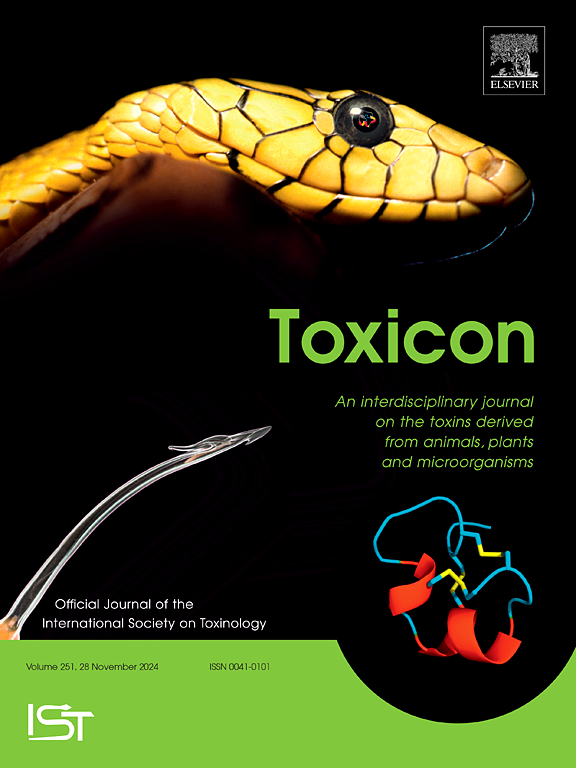麦角多糖通过激活NRF-2/GPX和AhR/STAT3信号通路减轻黄曲霉毒素B1对肝脏的毒性。
IF 2.6
4区 医学
Q2 PHARMACOLOGY & PHARMACY
引用次数: 0
摘要
黄曲霉毒素 B1(AFB1)可导致人体肝脏严重中毒。虽然很难完全避免接触黄曲霉毒素 B1,但可以通过从膳食中摄取天然产品来减轻其对健康的不利影响。玛咖(Lepidium meyenii)的根部含有丰富的有益多糖。在这里,我们首先评估了MPs的膳食安全性,然后研究了MPs对AFB1肝脏毒性的缓解作用。对小鼠进行为期 28 天的亚急性给药,结果表明,剂量为 0.2∼1.2 克/千克体重/天的玛咖多糖对小鼠是安全的,能显著提高小鼠的耐力。此外,用 25 ∼ 100 μg/mL 的 MPs 处理人 PC12 细胞也未观察到毒性,成功地缓解了钴引起的细胞凋亡 ∼ 20%。在抗 AFB1 肝毒性功能方面,0.4∼1.6 克/千克体重/天的 MPs 能显著减轻 AFB1 处理小鼠的肝组织损伤、脂质积累、ROS 损伤、NF-κB p65、细胞因子如 IL-6 和 TNF-α 的分泌。流式细胞术发现,MPs 处理可恢复 AFB1 处理小鼠初级巨噬细胞中 F4/80 的升高。在分子水平上,MPs 处理可激活肝脏 NRF-2/GPX/SOD 抗氧化系统。在人巨噬细胞模型中,MPs 恢复了被 AFB1 破坏的 AhR/STAT3 通路和 Tnf-a、Inos、Arg-1 的 mRNA 表达。我们的研究结果不仅加深了人们对 AFB1 毒性机理的认识,还为利用 MPs 制定膳食干预策略提供了参考。本文章由计算机程序翻译,如有差异,请以英文原文为准。

Lepidium meyenii (Maca) polysaccharides mitigate liver toxicity of aflatoxin B1 through activation of NRF-2/GPX and AhR/STAT3 signaling pathways
Aflatoxin B1 (AFB1) can induce serious liver toxicity in human. While completely avoiding AFB1 exposure is difficult, dietary intake of natural products may be leveraged to mitigate its adverse health effects. The roots of Lepidium meyenii (Maca) is rich in beneficial polysaccharides. Here we first evaluated dietary safety of MPs and then investigated MPs mitigating effects on the liver toxicity of AFB1. A 28-day sub-acute administration of Maca polysaccharides (MPs) demonstrated to be safe in mice at dose 0.2–1.2 g/kg.bw/day that significantly elevated mice stamina. Also, no toxicity was observed in human PC12 cells treated with MPs 25–100 μg/mL which successfully alleviated cobalt-caused cell apoptosis by ∼20%. In terms of anti-AFB1 hepatoxicity function, MPs 0.4–1.6 g/kg.bw/day significantly alleviated liver tissue damage, lipid accumulation, ROS damage, NF-κB p65, secretion of cytokines such as IL-6 and TNF-α in AFB1-treated mice. Flow cytometry found that MPs treatment recovered the elevation of F4/80 in the primary macrophages of AFB1-treated mice. At molecular level, MPs treatment activated liver NRF-2/GPX/SOD anti-oxidant system. In human macrophage model, MPs restored the inflammatory AhR/STAT3 pathway and mRNA expressions of Tnf-a, Inos, Arg-1 disrupted by AFB1. Our findings not only add to the current understanding on the toxicity mechanism of AFB1, but also provide references to the development of dietary intervention strategy using MPs.
求助全文
通过发布文献求助,成功后即可免费获取论文全文。
去求助
来源期刊

Toxicon
医学-毒理学
CiteScore
4.80
自引率
10.70%
发文量
358
审稿时长
68 days
期刊介绍:
Toxicon has an open access mirror Toxicon: X, sharing the same aims and scope, editorial team, submission system and rigorous peer review. An introductory offer Toxicon: X - full waiver of the Open Access fee.
Toxicon''s "aims and scope" are to publish:
-articles containing the results of original research on problems related to toxins derived from animals, plants and microorganisms
-papers on novel findings related to the chemical, pharmacological, toxicological, and immunological properties of natural toxins
-molecular biological studies of toxins and other genes from poisonous and venomous organisms that advance understanding of the role or function of toxins
-clinical observations on poisoning and envenoming where a new therapeutic principle has been proposed or a decidedly superior clinical result has been obtained.
-material on the use of toxins as tools in studying biological processes and material on subjects related to venom and antivenom problems.
-articles on the translational application of toxins, for example as drugs and insecticides
-epidemiological studies on envenoming or poisoning, so long as they highlight a previously unrecognised medical problem or provide insight into the prevention or medical treatment of envenoming or poisoning. Retrospective surveys of hospital records, especially those lacking species identification, will not be considered for publication. Properly designed prospective community-based surveys are strongly encouraged.
-articles describing well-known activities of venoms, such as antibacterial, anticancer, and analgesic activities of arachnid venoms, without any attempt to define the mechanism of action or purify the active component, will not be considered for publication in Toxicon.
-review articles on problems related to toxinology.
To encourage the exchange of ideas, sections of the journal may be devoted to Short Communications, Letters to the Editor and activities of the affiliated societies.
 求助内容:
求助内容: 应助结果提醒方式:
应助结果提醒方式:


